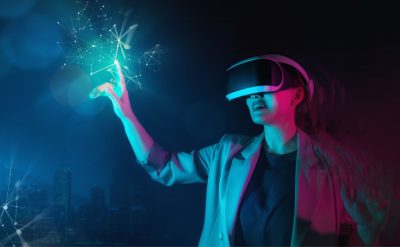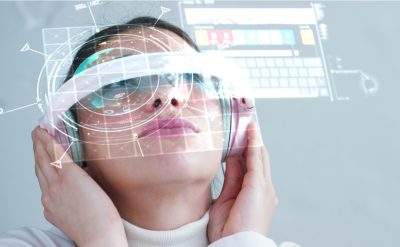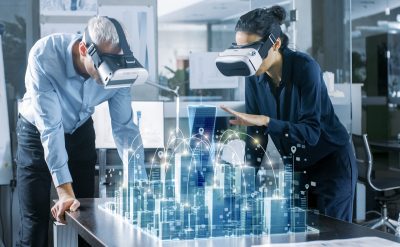With immersive technology, brands can seemingly offer unlimited potential to communicate with the audience to give a unique, memorable, and highly customized experience.
By implementing augmented reality, virtual reality, and 360 videos into marketing campaigns, e-commerce efforts, in-store shopping experiences, and employee training exercises, the organizations can help cultivate brand loyalty, improve employee knowledge, and prepare for an even more tech-driven future.
Organizations can also help brand loyalty grow by making online and in-store shopping more comfortable and enjoyable. Working to improve the customer experience further by developing employee skill sets with AR or VR-assisted training is also one of the major steps to help organizations stay a step ahead.
What seemed unbelievable just a few years ago is practical, and companies are finding new applications for these innovations every day.
How AR is practiced in various sectors
1. Shopping made more real
Augmented reality is now the future of shopping. Retailers are coming up with innovative ideas to provide customers an augmented reality shopping experience. Brands are on the verge of using interactive mirrors to navigate inside the store through AR apps. This will totally change the customer’s way of interacting with retailers.
The physical store helps to look around and browse through various sections to find the product of one’s choice. Checking around the entire store is a tedious task and leads to heads down if the required product is not found. The in-store experience is made more informational, faster, and seamless by retailers after introducing augmented reality navigation.
Lowe’s, a global hardware retail chain, is a perfect example of this. It has introduced Lowe Vision, a mobile app to help navigate the store based on the requirement. The app allows to create shopping lists using the available catalogs and then guides through the fastest path to reach those products while displaying various details.
2. Training new employees
Training is essential for all organizations, let that be for onboarding new employees or letting existing team members work on their newer skill sets. Replicating things is difficult sometimes. During such times, it’s the immersive technology that can bridge the gap and ensure that employees are prepared.
Educating the sales team on the newly launched product is an expensive and complicated affair. It becomes more tedious when employees are situated at different locations scattered all around the world. As a solution, Walmart created “Walmart Academies,” a system that lets organizations improve employee experience, assess workers’ skills, and deliver training to make the processes simpler. It tries to recreate a scenario for the employees in a safe environment. The system proved successful as it is closely associated with delivering to buyers providing the best customer experience possible.
3. Tried and tested
Trying any product even before purchasing it gives the customer a better idea of settling with the right product. This will contribute to more positive reviews about the products from the customers. Adopting such strategies will help gain positive results for various fields such as fitting rooms, cosmetic samples, or even automobile test drives.
AR gives an augmented shopping experience to customers where users can try out makeup, clothes, footwear, etc., using their digital identity. This also helps to save the space for a large physical inventory that contains different samples that can be tried and tested.
Sephora cosmetic company is already using an AR app that enables the buyers to try the cosmetic products on their face even before buying them. This helps customers to get a clear view of what will look good on them. The company’s ModiFace AR technology can show the users the effect of skincare on their skin after using the product for said amount of time.
4. Virtual customer service
Working with AR has made customers lessen the need to connect customer-care staff. Many businesses are implementing AR for self-service support for the purchased product. Customers can quickly get an in-depth self-service overlay of the product using an AR app by merely pointing the phone at the product.
The overlay includes all the FAQs and the help sheets required by the customers at their fingertips. It will help find answers to common questions, ultimately saving time and reducing the team’s work burden. This will also result in fewer customer queries, and the rate of customer satisfaction will also remain high as all the user queries will be solved at the individual level.
For instance, Mercedes has designed an AR app Ask Mercedes virtual assistant. The app lets the driver scan any element of the vehicle and have its functionality explained to them. It also assists in answering questions about any problems or faults in its operations. The combination of AI chatbot and the AR element of the virtual assistant makes it more user-friendly.
5. Interactive packaging
Interactive packaging can be the most exciting thing about AR when it comes to sales. It is one of the best examples of promoting sales using AR.
Interactive packaging offers customers a more engaging and valuable experience through AR. Targeting their phones at a product’s packaging makes customers see compelling visuals.
For instance, the food processing company Heinz has used interactive packaging to deliver useful, practical insights to provide customers easy access to a range of recipes using tomato ketchup.
Cereal makers like Nesquik and Wheaties offer AR games to play that make it more fun at the breakfast table. No matter the exact use, interactive packaging is a further example of AR boosting customer experience.
AR leading toward developed future
Immersive technology is no more a far-fetched dream. It is successfully executing the most memorable customer experiences and has proven itself different from the other brands in constantly increasing competition.
Augmented reality comes with immense benefits for various industries. Thus marketers, irrespective of the industry, are tailored to adopt this technology to increase sales.
It includes advancement from the use of flyers, PowerPoint presentations, brochures to adopt this modern technology to offer augmented customer experiences.
AR creates a smooth path for the customer journey. It should be the first and topmost priority of retailers or marketers. And AR can help build a frictionless path with new ways of shopping, interacting, visualizing, and more.
For more such insightful content, download our latest whitepapers on technology and augmented reality.









